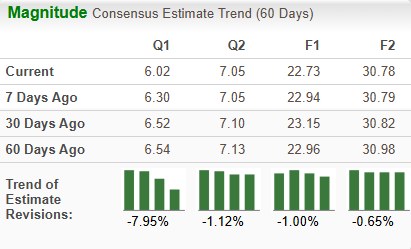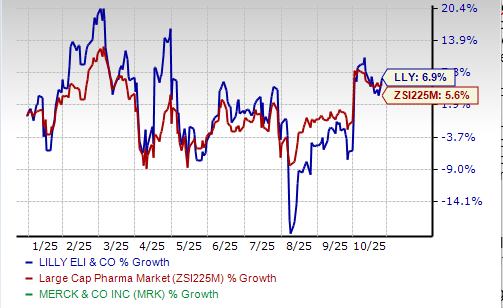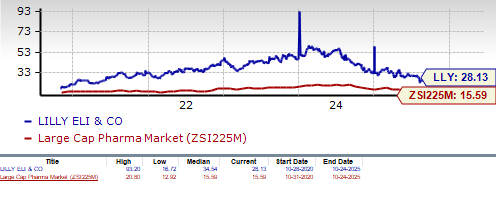|
|
|

|
|||||

|
|
Eli Lilly and Company LLY will report its third-quarter 2025 earnings on Oct. 30, before market open. The Zacks Consensus Estimate for sales and earnings is pegged at $16.01 billion and $6.02 per share, respectively. Earnings estimates for 2025 have declined from $23.15 per share to $22.73 per share over the past 30 days.

The healthcare bellwether’s performance has been mixed, with the company exceeding earnings expectations in two of the trailing four quarters while missing in the remaining two. It delivered a four-quarter earnings surprise of negative 2.31%, on average. In the last reported quarter, the company delivered a positive earnings surprise of 12.48%, as seen in the chart below.

Lilly has an Earnings ESP of -0.66% and a Zacks Rank #3 (Hold). You can see the complete list of today’s Zacks #1 Rank (Strong Buy) stocks here.
Per our proven model, companies with the combination of a positive Earnings ESP and a Zacks Rank #1, #2 (Buy) or #3 have a good chance of delivering an earnings beat. You can uncover the best stocks to buy or sell before they’re reported with our Earnings ESP Filter.
In the third quarter, like the previous two quarters, the key drivers of Lilly’s top-line growth are expected to have been its popular GLP-1 drugs, diabetes drug Mounjaro and weight loss medicine, Zepbound, driven by high demand trends.
Launches of these drugs in new international markets and improved supply from ramped-up production in the United States led to strong sales in the first half of 2025. The positive trend is expected to have continued. Approvals for new indications may have also driven sales of Mounjaro and Zepbound higher.
The Zacks Consensus Estimate for Mounjaro and Zepbound sales are $5.48 billion and $3.45 billion, respectively. Our estimates for Mounjaro and Zepbound are $5.33 billion and $3.46 billion, respectively.
Effective July 1, CVS Caremark, a major pharmacy benefit manager, began excluding Zepbound from its preferred drug list while retaining rival Novo Nordisk’s NVO obesity drug, Wegovy. On the second-quarter conference call, Lilly had mentioned that this decision hurt Zepbound prescriptions during July and is expected to be a headwind to the rate of volume growth in the third quarter. Investors will be keen to get an update on the third-quarter conference call.
Higher demand and volume growth for Lilly’s other key growth drugs like Emgality, Olumiant, Taltz and Verzenio are likely to have provided top-line support in the third quarter.
While volumes are expected to have increased for most drugs, lower realized prices (including U.S. Part D changes) are likely to have continued to hurt sales of most drugs.
Sales of Trulicity are likely to have been hurt by competitive dynamics, including patient switches to Mounjaro and lower realized prices. Jardiance’s revenues declined in the second quarter. It remains to be seen if its sales trends improved in the third quarter.
The Zacks Consensus Estimate for Trulicity, Taltz, Verzenio, Jardiance, Olumiant and Emgality is $1.05 billion, $919.0 million, $1.58 billion, $687 million, $263 million and $196 million, respectively.
Our estimates for Trulicity, Taltz, Verzenio, Jardiance, Olumiant, and Emgality are $1.04 billion, $911.5 million, $1.64 billion, $630.6 million, $257.7 million and $186.4 million, respectively.
Newer products like Ebglyss, Jaypirca, Kisunla and Omvoh are likely to have contributed to sales growth.
Sales of most established drugs like Forteo, Humalog and Humulin are likely to have declined in the quarter.
Higher marketing, selling and administrative expenses to support the launch of new products and indications are likely to have hurt operating profits in the quarter.
Nonetheless, a single quarter’s results are not so important for long-term investors. Let us delve deeper to understand whether to buy, sell or hold Lilly’s stock.
Lilly’s stock has risen 6.9% so far this year compared with the industry’s increase of 5.6%.

The stock is trading at a premium to the industry, as seen in the chart below.

Lilly’s success is primarily attributed to its widely used GLP-1 therapies — Mounjaro and Zepbound.
Despite being on the market for only around three years, Mounjaro and Zepbound have become key top-line drivers for Lilly, with demand rising rapidly. Mounjaro and Zepbound account for around 50% of the company’s total revenues.
In addition to Mounjaro and Zepbound, Lilly has gained approvals for several other new drugs over the past couple of years across various therapeutic areas, including Omvoh, Jaypirca, Ebglyss, and Kisunla (donanemab). Lilly expects its new drugs, Mounjaro, Zepbound, Omvoh, Jaypirca, Ebglyss and Kisunla, along with the expanded use of existing drugs, to continue to drive sales growth.
Lilly is investing broadly in obesity and has several new molecules currently in clinical development with a range of oral and injectable medications with different mechanisms of action. These include two late-stage candidates, orforglipron, a once-daily oral GLP-1 small molecule, and retatrutide, a GGG tri-agonist and some mid-stage candidates, bimagrumab, eloralintide and mazdutide.
Lilly has announced mixed data from two studies on orforglipron in obesity. An oral pill like orforglipron has the potential to be a more convenient alternative to injectable treatments like Zepbound and NVO’s Wegovy. Lilly plans to file regulatory applications for orforglipron in obesity later this year, setting up the timeline for a potential launch next year.
LLY is also working to diversify beyond GLP-1 drugs by expanding into cardiovascular, oncology, and neuroscience areas. In 2025, it announced several M&A deals. It acquired Verve Therapeutics to add gene therapies for heart disease to its pipeline. Lilly has also entered into agreements to acquire Scorpion Therapeutics’ oncology drug and SiteOne Therapeutics’ non-opioid pain candidate.
Last week, Lilly announced a definitive agreement to acquire Adverum Biotechnologies ADVM, which will add the latter’s lead candidate, Ixo-vec, an intravitreal single-administration gene therapy being developed in phase III to treat vision loss associated with wet age-related macular degeneration. Ixo-vec has the potential to transform chronic eye care into a one-time treatment.
Lilly has its share of problems. Prices of most of Lilly’s products are declining in the United States. Potential competition in the GLP-1 diabetes/obesity market is a key headwind.
Mounjaro and Zepbound face strong competition from Novo Nordisk’s semaglutide medicines, Ozempic for diabetes and Wegovy for obesity.
Several other companies, like Amgen and Viking Therapeutics (VKTX), are also making rapid progress in the development of more potent and convenient GLP-1-based candidates in their clinical pipeline.
NVO, LLY and VKTX are racing to introduce oral weight-loss pills, as Wegovy and Zepbound are both injectable drugs. Novo Nordisk has already filed a new drug application (NDA) for an oral version of Wegovy and also has several next-generation candidates in its obesity pipeline, like CagriSema (a combination of semaglutide and cagrilintide) and an oral pill, amycretin (a dual GLP-1 and amylin receptor agonist). The FDA is expected to decide on the Wegovy oral formulation NDA later this year.
Despite its expensive valuation, we suggest investors retain this stock as it is the largest drugmaker currently and has robust growth prospects.
Want the latest recommendations from Zacks Investment Research? Today, you can download 7 Best Stocks for the Next 30 Days. Click to get this free report
This article originally published on Zacks Investment Research (zacks.com).
| Dec-13 | |
| Dec-13 | |
| Dec-13 | |
| Dec-13 | |
| Dec-12 | |
| Dec-12 |
Eli Lilly Rises, Again, After EMA Groups Recommends Mounjaro For Children As Young As 10
LLY NVO
Investor's Business Daily
|
| Dec-12 | |
| Dec-12 | |
| Dec-12 | |
| Dec-12 | |
| Dec-12 | |
| Dec-12 |
Eli Lilly Rises, Again, After EMA Recommends Mounjaro For Children As Young As 10
LLY
Investor's Business Daily
|
| Dec-12 | |
| Dec-12 |
Dow Jones, Russell 2000 Hit Highs, Buoyed By Fed; Oracle, Broadcom Weigh On Techs: Weekly Review
LLY
Investor's Business Daily
|
| Dec-12 |
Join thousands of traders who make more informed decisions with our premium features. Real-time quotes, advanced visualizations, backtesting, and much more.
Learn more about FINVIZ*Elite